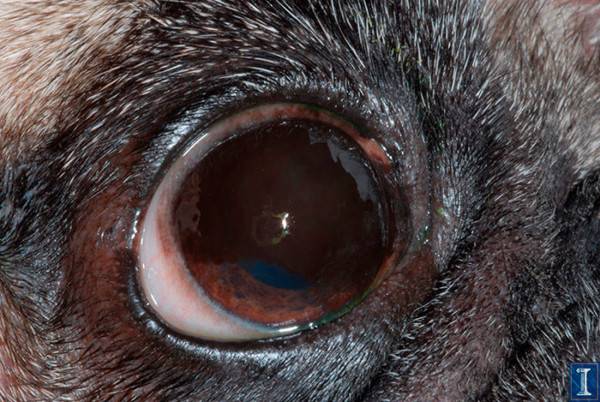Dog keratitis is an inflammatory disease of the eye systems affecting the ocular cornea. This pathology is enough widespread among pets. Keratitis causes discomfort to the animal and threatens with very serious complications, prevented by a competent, timely started treatment and compliance with basic preventive measures.
Content
- 1. Causes of keratitis in dogs
- 2. Symptoms of canine keratitis
- 3. Species of keratitis in dogs
- 4. Methods of treating keratitis usobak
- 5. Prevention measures
Causes of keratitis in dogs
Contents

Keratitis in a dog in the photo
Causes of the occurrence and development of keratitis in representatives the canine ones are quite diverse. However, veterinarians distinguish a number of factors that can provoke the development of such a disease. To them relate:
- Traumatic eye damage.
- Avitaminosis.
- Burn injuries of the eye surface.
- Infectious hepatitis.
- Enteritis.
- Genetic predisposition.
- Disorders in the activity of the endocrine system.
- Weakened immunity.
- Diabetes.
- Increased tendency to allergic reactions.
- Plague.
- Ingestion in the eye region of foreign bodies.
- Inflammatory processes localized in the area of organs view.
It should be emphasized that keratitis can be infectious or same invasive character. Depending on the type of disease, it the occurrence can be triggered by specific viruses, adenoviruses, bacteria, pathogenic fungi – actinomycetes or but with special filamentous parasites — telases.
Symptoms of canine keratitis

Pigment keratitis in a dog with symptoms of lacrimation
Regardless of the type and form of the course of this pathology, keratitis in dogs manifests itself with specific characteristic symptoms:
- Profuse lacrimation.
- The development of photophobia.
- Opacification of the cornea.
- Swelling.
- Hyperemia of the sclera and conjunctiva.
- The appearance of purulent ocular discharge.
- The appearance of yellow, white and gray spots in the cornea eyes.
- Redness of the mucous membranes and eye protein.
- Frequent blinking.
- Roughness of the ocular membrane.
- The appearance of dark smudges localized in the inner corners eyes.
Keratitis in dogs is characterized by a rapid course, therefore diagnosing this ailment is quite simple. Ophthalmic opacification corneas can be detected almost after a couple of hours after the onset of the disease. Significantly changes and manner pet behavior – the animal becomes nervous restless, depressed and lethargic, hiding from the light and constantly rubs his eyes with his paws.

Lens clouding in a dog is a clear sign of keratitis
If you do not treat it in a timely manner and start the disease, then it begins progress, resulting in inflamed blood vessels grow into the ocular cornea, making it bumpy and thickened.
It should be noted that keratitis is fraught with the development of such complications, as the development of glaucoma, cataract, perforation of the ocular cornea, partial or complete loss of visual function. Therefore, having discovered the pet has the first signs of keratitis, immediately head to the veterinary clinic for examination by a veterinarian and the appointment of proper treatment.
Species of keratitis in dogs
Veterinary specialists distinguish several varieties canine keratitis, which are somewhat different in pathogenesis, signs and features of occurrence:
- Purulent superficial type of keratitis – in mainly due to mechanical damage to the mucous membranes eye membranes. This form of keratitis is characterized by the appearance of the animal has a pronounced photophobia, profuse lacrimation and the appearance of purulent discharge.
- Parenchymal keratitis – is microbial character. The disease can develop against the background of a dog’s plague, toxoplasmosis or in the presence of wound damage, localized in the area of the ocular surface. Eyes sick the animal begins to water heavily, the cornea becomes edematous, and not on its surface, characteristic spots and dots appear. Quite often, parenchymal keratitis is accompanied by development iris or conjunctivitis.
- Spot keratitis is one of the rarest forms diseases, the exact causes of which today day is not fully understood. Typical symptoms include the appearance of pearly muddy spots on the surface of the affected eye ailment. In this case, the animal feels normal and his visual function does not deteriorate at all.
- Conflictful keratitis – develops on the background poisoning of a toxic nature or allergic reactions. By According to veterinarians, this kind of keratitis most Collie dogs as well as shepherd dogs are affected. Disease characterized by the appearance of large vesicles on the ocular cornea grayish-white color. In the absence of timely treatment, they can merge and burst, as a result of which the cornea acquires reddish gray color. Conflictful keratitis is also characterized thickening and tuberosity of the third century.
- Ulcerative keratitis occurs on the background of ulcerative lesions of the ocular cornea. The surface of the eyeball becomes cloudy and foggy. With a fairly long course diseases, the formation of open ulcerative surfaces in areas of the cornea.
Treatment methods for keratitis usobak

Before starting treatment, be sure to go to ophthalmologist to clarify the diagnosis
Keratitis responds fairly well to early treatment the occurrence of pathology. Otherwise, the disease may go in a chronic form in which periods of remission alternate with acute relapses. Therefore, it is imperative that treatment of keratitis in The pet was started on time.
Features of therapy depend on the type of disease, as well as on factors that provoked its development. First of all, the veterinarian removes the cause that led to the occurrence of keratitis, only in this case, further therapy will bring positive, stable results.
Mandatory treatment procedures include daily washing the lacrimal sacs with a solution of Furatsilin, Rivanol or boric acid, which have an antispetic effect.

With all types of keratitis, except purulent, allergic and superficial dog is prescribed a course of antibiotics
With the advanced form of the disease, after stopping inflammation, tissue therapy may be recommended for the animal. Besides, for resorption of scars in the eye cornea lidase and yellow mercury ointment. In some severe cases, surgical treatment may be required superficial keratectomy.
It must be emphasized that select specific medications drugs, determine the appropriate dosage and duration treatment course should only be a veterinarian! In this case, the specialist takes into account factors such as the overall clinical picture, form and stage of the disease, breed and body weight of the animal.
On average, treating keratitis in dogs takes 1-2 months. At timely initiation of therapy and compliance with recommendations veterinarian general prognosis for this disease is quite favorable. It is impossible to ignore the signs of keratosis, since with lack of operational measures, this disease is fraught with permanent clouding of the cornea, visual impairment, and even complete blindness!
Preventive measures
Prevention of keratosis in dogs involves simple recommendations:
- Regular vaccination of the animal against adenoviruses and herpes.
- Care must be taken to prevent possible traumatic pet eye damage.
- Consult a specialist in time in case of conjunctivitis or other eye diseases in the dog.
- Be sure to follow a balanced, rational animal nutrition to prevent the development of vitamin deficiency and weakening of the immune system.
- Provide the pet with proper care, comb it regularly coat and trim the coat located around eye.
- Rinse the dog’s eyes regularly with cotton pads dipped in chamomile broth, tea leaves or a solution of boric acid.
Keratosis in dogs – responds well enough to treatment. Observing recommendations of an animal care specialist, you can prevent the development of undesirable consequences, achieving full healing a pet – without complications and relapses!






